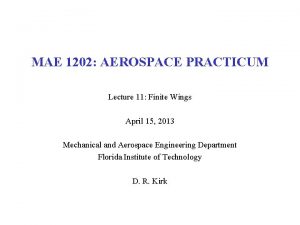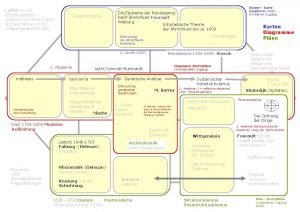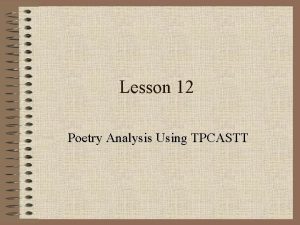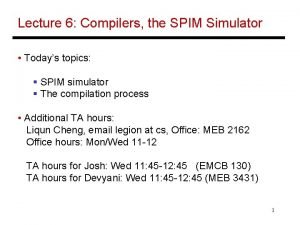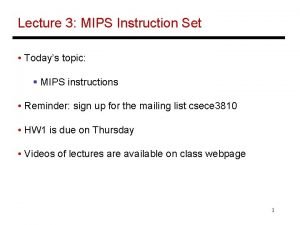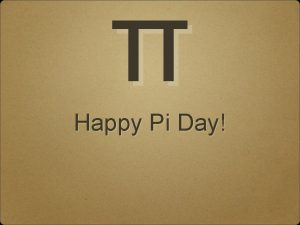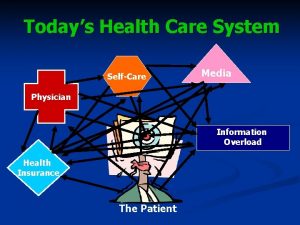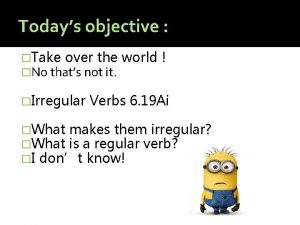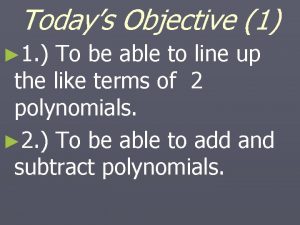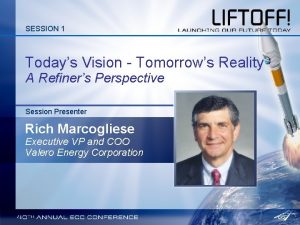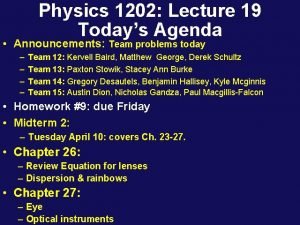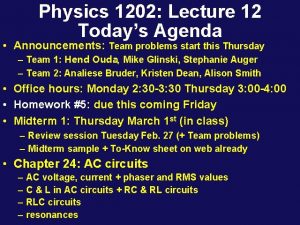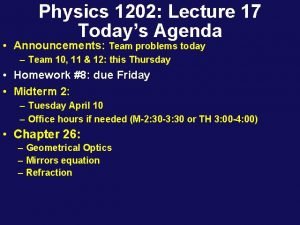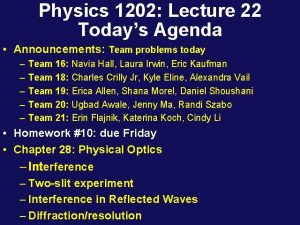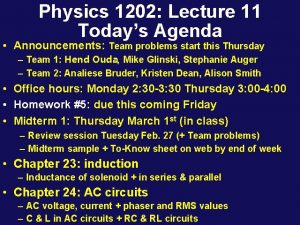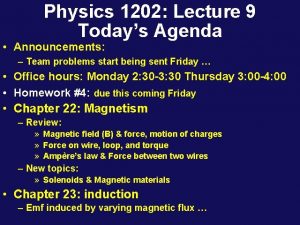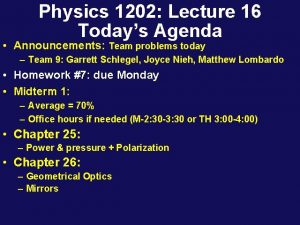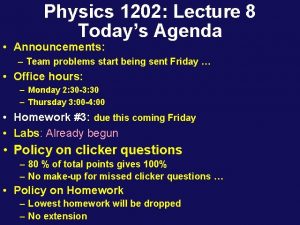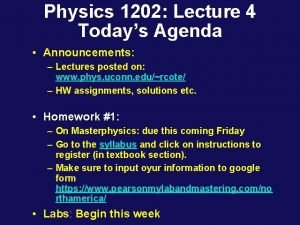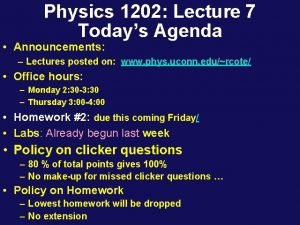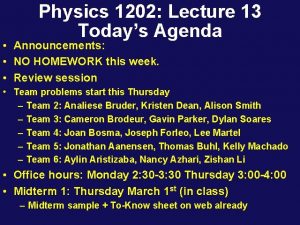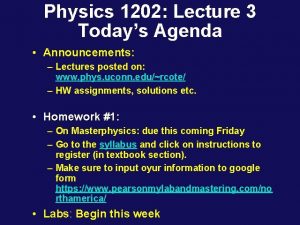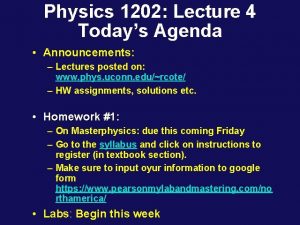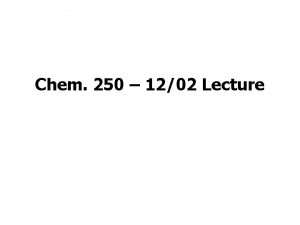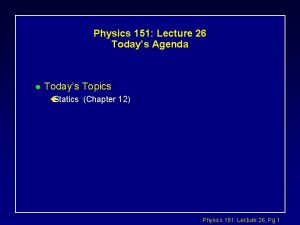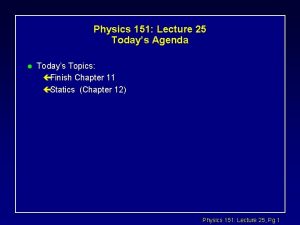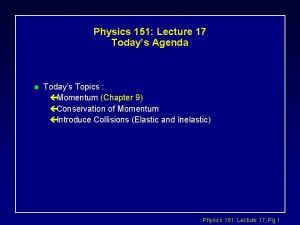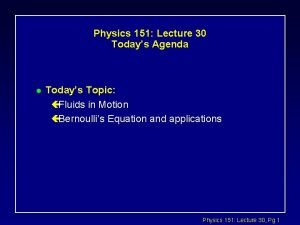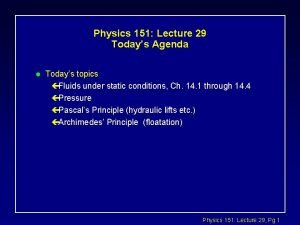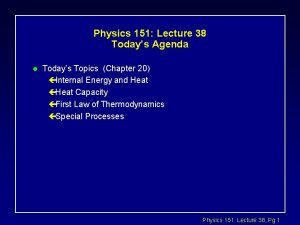Physics 1202 Lecture 14 Todays Agenda Announcements Team







































- Slides: 39

Physics 1202: Lecture 14 Today’s Agenda • Announcements: Team problems for. Thursday – Team 7: Cailin Catarina, Matthew Canapetti, Kervin Vincent – Team 8: Natalie Kasir, Adam Antunes, Quincy Alexander – Team 9: Garrett Schlegel, Joyce Nieh, Matthew Lombardo • Office hours: Monday 2: 30 -3: 30 Thursday 3: 00 -4: 00 • Homework #6: due this coming Friday • Midterm 1: – Solutions in class – Midterm sample + To-Know sheet on web already • Chapter 25: E&M waves – Production and properties

R C e ~ L

24 -5 RLC Circuits • Phasor diagram – useful to analyze an RLC circuit • Follow the loop • Total V V= VR + VL+ VC = Z Imax – VR = R Imax (in phase) – VL= XL Imax (leads by 90 o) – VC= XC Imax (lags by 90 o)

24 -5 RLC Circuits • The phase angle for an RLC circuit is: • If XL = XC, the phase angle is zero, and the voltage and current are in phase. • The power factor:

24 -6: Resonance - LC Circuits • Consider the LC and RC series circuits shown: C R C L • Suppose that the circuits are formed at t=0 with the capacitor C charged to a value Q. Claim is that there is a qualitative difference in the time development of the currents produced in these two cases. Why? ? • Consider from point of view of energy! • In the RC circuit, any current developed will cause energy to be dissipated in the resistor. • In the LC circuit, there is NO mechanism for energy dissipation; energy can be stored both in the capacitor and the inductor!

RC/LC Circuits i i Q +++ Q C +++ --- C R LC: current oscillates RC: current decays exponentially 0 i -i 0 0 1 t L t

The energy in LC circuit conserved ! When the capacitor is fully charged: When the current is at maximum (Io): The maximum energy stored in the capacitor and in the inductor are the same: At any time:

Resonance • For fixed R, C, L the current im will be a maximum at the resonant frequency 0 which makes the impedance Z purely resistive. ie: reaches a maximum when: XL=XC the frequency at which this condition is obtained is given from: Þ • Note that this resonant frequency is identical to the natural frequency of the LC circuit by itself! • At this frequency, the current and the driving voltage are in phase!

24 -6 Resonance in Electrical Circuits • In an RLC circuit with an ac power source, the impedance is a minimum at the resonant frequency: XL=XC the frequency at which this condition is obtained is given from: Þ

Resonance The current in an LCR circuit depends on the values of the elements and on the driving frequency through the relation Z | XL-XC | | R “ Impedance Triangle” Suppose you plot the current versus , the source voltage frequency, you would get: m / R 0 R=Ro im 0 R=2 Ro 0 1 x 2 2 o

Application of Resonance o Tuning a radio o A varying capacitor changes the resonance frequency of the tuning circuit in your radio to match the station to be received o Metal Detector o The portal is an inductor, and the resonant frequency is set to a condition with no metal present o When metal is present, it changes the effective inductance, which changes the current o The change in current is detected an alarm sounds

Fields from Circuits? • We have been focusing on what happens within the circuits we have been studying (eg currents, voltages, etc. ) • What’s happening outside the circuits? ? – We know that: » charges create electric fields and » moving charges (currents) create magnetic fields. – Can we detect these fields? – Demos: » We saw a bulb connected to a loop glow when the loop came near a solenoidal magnet. » Light spreads out and makes interference patterns. Do we understand this?

Chap. 25 f( x ) x x z y

Maxwell’s Predictions • Maxwell thought that electric and magnetic fields play symmetric roles in nature • Since a varying B induces an emf and hence E (Faraday’s Law), he hypothesized that a changing E would produce a B o field o • Maxwell calculated the speed of o light to be 3 x 108 m/s • He concluded that visible light and all other electromagnetic waves consist of fluctuating E and B fields, with each varying field inducing the other James Clerk Maxwell 1831 – 1879 Electricity and magnetism were originally thought to be unrelated In 1865, James Clerk Maxwell provided a mathematical theory that showed a close relationship between all electric and magnetic phenomena Light: electromagnetic waves

Maxwell’s Equations • These equations describe all of Electricity and Magnetism. • They are consistent with modern ideas such as relativity. • They describe light ! (electromagnetic wave)

Hertz’s Confirmation of Maxwell’s Predictions o o Hertz measured the speed of the waves from the transmitter • He used the waves to form an interference pattern and calculated the wavelength • From v = f λ, v was found • v was very close to 8 • 3 x 10 m/s, the known speed of light This provided evidence in support of Maxwell’s theory • 1857 – 1894 • First to generate and detect electromagnetic waves in a laboratory setting • Showed radio waves could be reflected, refracted and diffracted • The unit Hz is named for him

25 -1: Generating E-M Waves • Static charges produce a constant Electric Field but no Magnetic Field. • Moving charges (currents) produce both a possibly changing electric field and a static magnetic field. • Accelerated charges produce EM radiation (oscillating electric and magnetic fields). • Antennas are often used to produce EM waves in a controlled manner.

• A Dipole Antenna V(t)=Vocos( t) + + - E E + + - • time t=0 x z y • time t= /2 • time t= / one half cycle later

EM Waves Produced by Antenna • Two rods are connected to an ac source, charges oscillate between o the rods (a) • As oscillations continue, the rods become less charged, the field near the charges decreases and the field o produced at t = 0 moves away from the rod (b) • The charges and field reverse (c) o • The oscillations continue (d) Because the oscillating charges in the rod produce a current, there is also a magnetic field generated As the current changes, the magnetic field spreads out from the antenna The magnetic field is perpendicular to the electric field

Electromagnetic Waves are Transverse Waves • The E and B fields are perpendicular to each other • Both fields are perpendicular to the direction of motion • Therefore, em waves are transverse waves o The ratio of the electric field to the magnetic field is equal to the speed of light

E & B in Electromagnetic Wave • Plane Harmonic Wave: where: y x z Note: the direction of propagation where is given by the cross product are the unit vectors in the (E, B) directions. Nothing special about (Ey, Bz); eg could have (Ey, -Bx) Note cyclical relation:

Lecture 14, ACT 1 • Suppose the electric field in an e-m wave is given by: – In what direction is this wave traveling ? (a) + z direction (c) +y direction (b) -z direction (d) -y direction

Lecture 14, ACT 2 • Suppose the electric field in an e-m wave is given by: • Which of the following expressions describes the magnetic field associated with this wave? (a) Bx = -(Eo/c)cos(kz + t) (b) Bx = +(Eo/c)cos(kz - t) (c) Bx = +(Eo/c)sin(kz - t)

Electromagnetic Waves produced by dipole • Any time an electric charge is accelerated, it will radiate: • Accelerated charges radiate electromagnetic waves.

Dipole radiation pattern proportional to sin( t) • oscillating electric dipole generates e-m radiation that is polarized in the direction of the dipole • radiation pattern is doughnut shaped & outward traveling – zero amplitude directly above and below dipole – maximum amplitude in-plane

E & B Fields in EM wave • How it looks like …

Receiving E-M Radiation receiving antenna y Speaker x z One way to receive an EM signal is to use the same sort of antenna. • Receiving antenna has charges which are accelerated by the E field of the EM wave. • The acceleration of charges is the same thing as an EMF. Thus a voltage signal is created.

Lecture 17, ACT 3 • Consider an EM wave with the E field POLARIZED to lie perpendicular to the ground. y x z In which orientation should you turn your receiving dipole antenna in order to best receive this signal? a) Along S b) Along B C) Along E

Loop Antennas Magnetic Dipole Antennas • The electric dipole antenna makes use of the basic electric force on a charged particle • Note that you can calculate the related magnetic field using Ampere’s Law. • We can also make an antenna that produces magnetic fields that look like a magnetic dipole, i. e. a loop of wire. • This loop can receive signals by exploiting Faraday’s Law. For a changing B field through a fixed loop of area A: FB= A B

Lecture 14, ACT 4 • Consider an EM wave with the E field POLARIZED to lie perpendicular to the ground. y x z In which orientation should you turn your receiving loop antenna in order to best receive this signal? a) â Along S b) â Along B C) â Along E

Review of Waves from 1201 • The one-dimensional wave equation: has a general solution of the form: where h 1 represents a wave traveling in the +x direction and h 2 represents a wave traveling in the -x direction. • A specific solution for harmonic waves traveling in the +x direction is: h l A x A = amplitude l = wavelength f = frequency v = speed k = wave number

E & B in Electromagnetic Wave • Plane Harmonic Wave: where: y x z • From general properties of waves : Þ

25 -2 The Propagation of EM Waves • All electromagnetic waves propagate through a vacuum at the same rate: • In materials, such as air and water, light slows down, but at most to about half the above speed • Using “tricks” of quantum mechanics – Can “stop” light in matter – More when we talk about modern physics !

Recall LC Circuits i The energy is conserved Q +++ C --- L LC: current oscillates i When the capacitor is fully charged: When the current is at maximum (Io): 0 t The maximum energy stored in the capacitor and in the inductor are the same:

Energy is Stored in fields • The energy density for a parallel plate capacitor: • The Electric field is given by: A ++++ ----- d Þ • The energy density u in the field is given by: • The energy density for a long solenoid: l • The inductance L is: r • Energy U: • The energy density N turns

Links between E & B • In LC, maximum energy in C and L are equal • If C and L have the same volume: u. E = u. B • E & B are related : • Units: e 0 = 8. 885× 10− 12 C 2/Nm 2 m 0 = 12. 566× 10− 7 N/A 2 • We can turn this into an energy density by dividing by the volume containing the field:

More about c • Units: e 0 = 8. 885× 10− 12 C 2/Nm 2 • m 0 = 12. 566× 10− 7 N/A 2 • [e 0 m 0 ] = (C 2/Nm 2) (N/A 2 )=(C 2/m 2) (s 2/C 2 )= s 2/ m 2 • So [e 0 m 0 ] = [1/v 2] • We have • Using values above: c=299, 276, 596 m/s ~ 3 X 108 m/s • And or

Velocity of Electromagnetic Waves • The wave equation for Ex: (derived from Maxwell’s Eqn) • Therefore, we now know the velocity of electromagnetic waves in free space: • Putting in the measured values for m 0 & e 0, we get: • This value is identical to the measured speed of light! – We identify light as an electromagnetic wave.

Recap of Today’s Topic : • Announcements: Team problems for. Thursday – Team 7: Cailin Catarina, Matthew Canapetti, Kervin Vincent – Team 8: Natalie Kasir, Adam Antunes, Quincy Alexander – Team 9: Garrett Schlegel, Joyce Nieh, Matthew Lombardo • Office hours: Monday 2: 30 -3: 30 Thursday 3: 00 -4: 00 • Homework #6: due this coming Friday • Midterm 1: – Solutions in class – Midterm sample + To-Know sheet on web already • Chapter 25: E&M waves – Production and properties
 Profile drag
Profile drag +1316
+1316 Bluetooth antenna length
Bluetooth antenna length Todays agenda
Todays agenda Pvu announcement today
Pvu announcement today /r/announcements
/r/announcements Church announcements
Church announcements Fahrenheit 451 pages
Fahrenheit 451 pages Kayl announcements
Kayl announcements General announcements
General announcements 01:640:244 lecture notes - lecture 15: plat, idah, farad
01:640:244 lecture notes - lecture 15: plat, idah, farad Agenda sistemica y agenda institucional
Agenda sistemica y agenda institucional Team building workshop agenda
Team building workshop agenda Physics 111 lecture notes
Physics 111 lecture notes What is a harmonic wave in physics
What is a harmonic wave in physics Phy101 lecture 1
Phy101 lecture 1 Physics 101 lecture notes pdf
Physics 101 lecture notes pdf Wave notes
Wave notes Atmospheric physics lecture notes
Atmospheric physics lecture notes Bureaucratic bypass syndrome
Bureaucratic bypass syndrome Team spirit becomes team infatuation
Team spirit becomes team infatuation The white team cheers for the blue team, just like
The white team cheers for the blue team, just like Generations
Generations Todays class
Todays class Todays with apostrophe
Todays with apostrophe Todays worldld
Todays worldld Whats todays temperature
Whats todays temperature Todays globl
Todays globl Todays wordlw
Todays wordlw Chapter 13 marketing in today's world
Chapter 13 marketing in today's world Todays plan
Todays plan Todays sabbath lesson
Todays sabbath lesson Welcome for sabbath school
Welcome for sabbath school Veseyans rfc
Veseyans rfc Todays health
Todays health Todays objective
Todays objective No thats not it
No thats not it Today's objective
Today's objective Todays whether
Todays whether Todays vision
Todays vision
